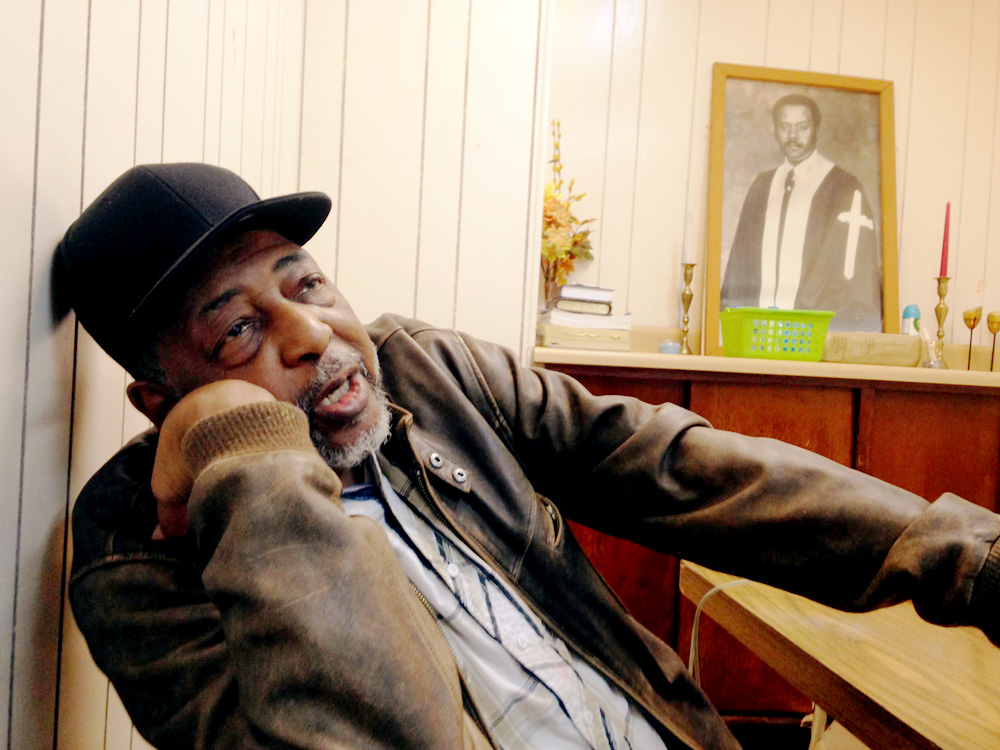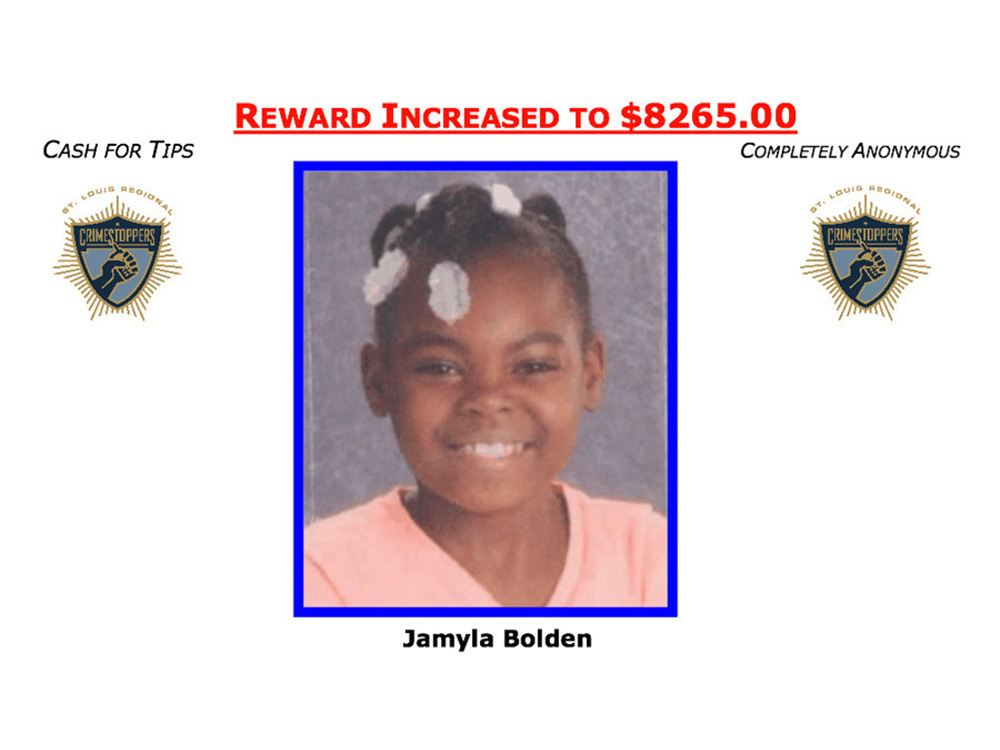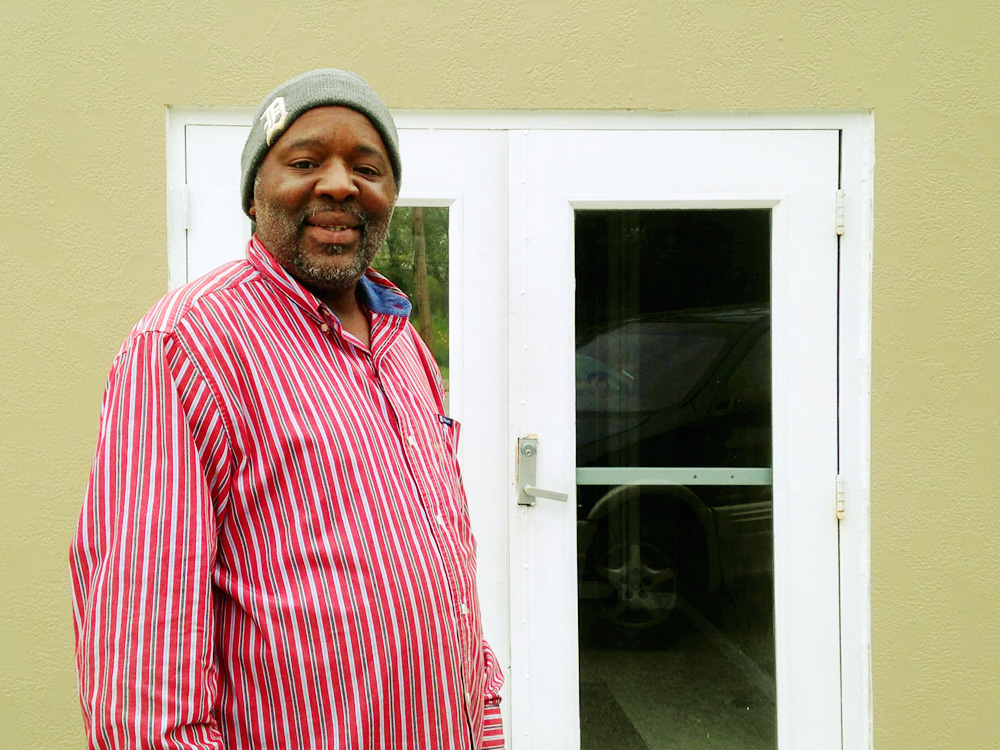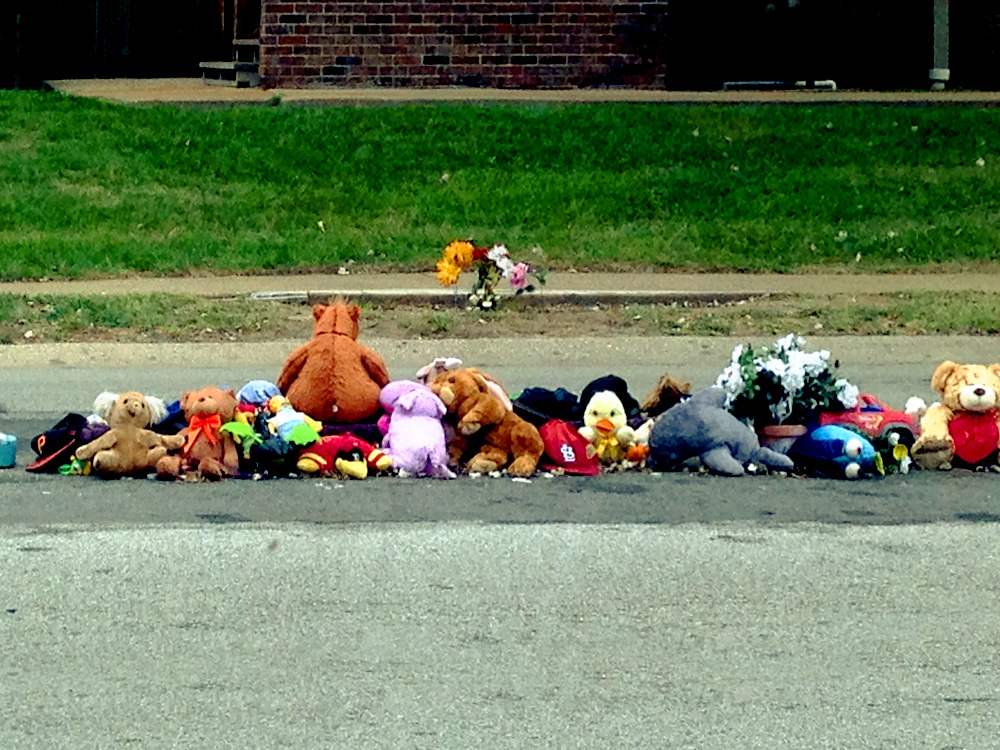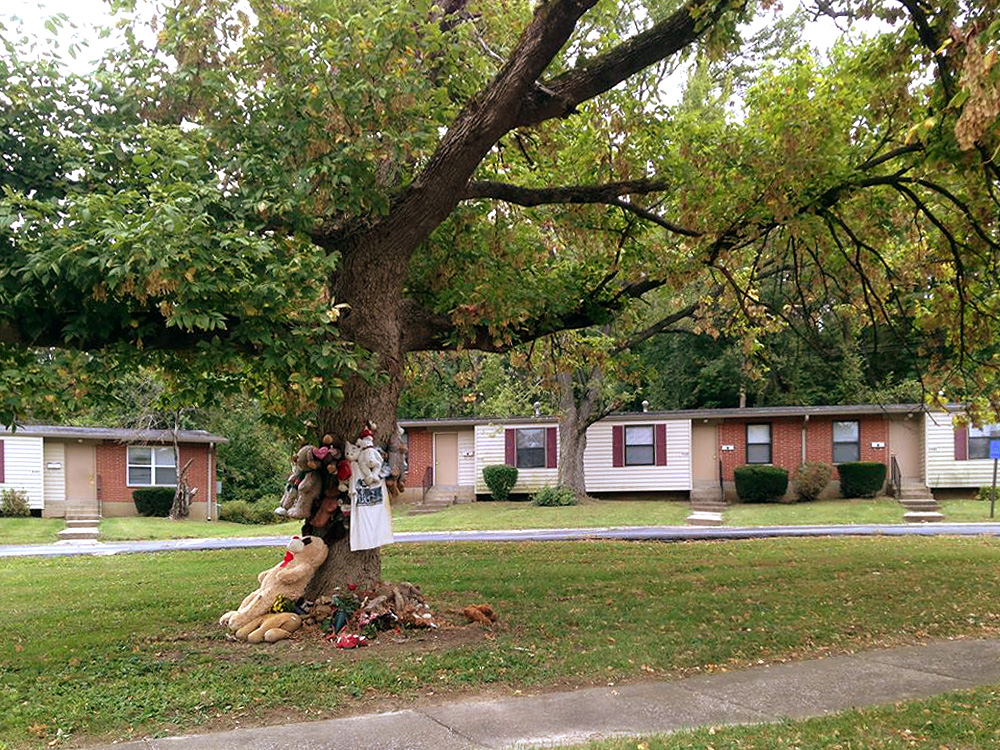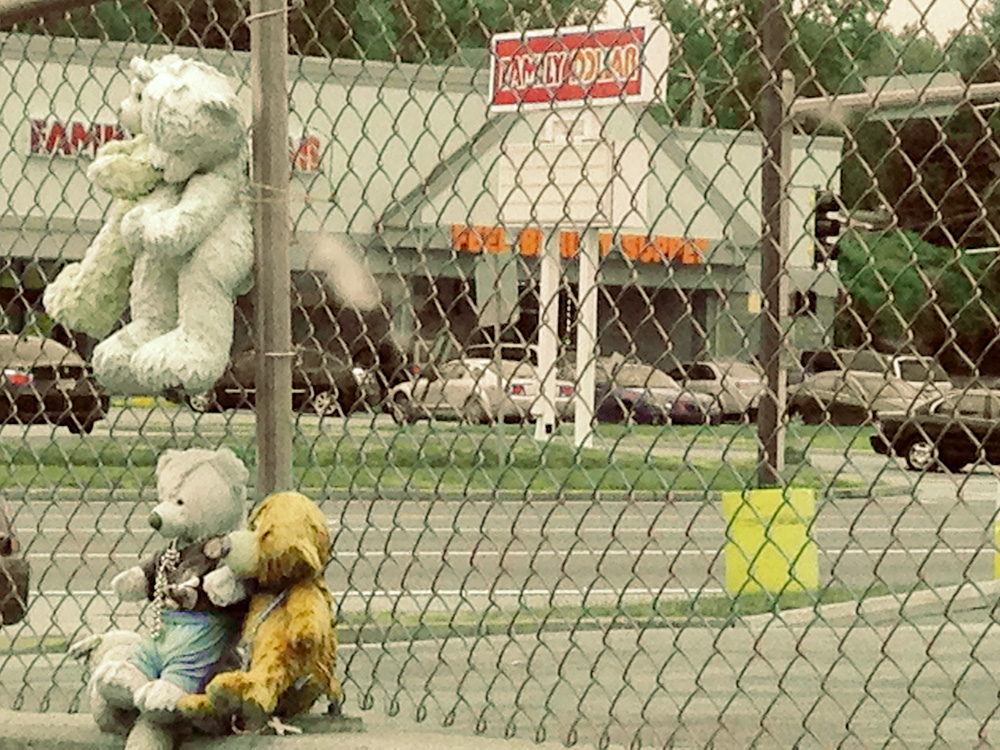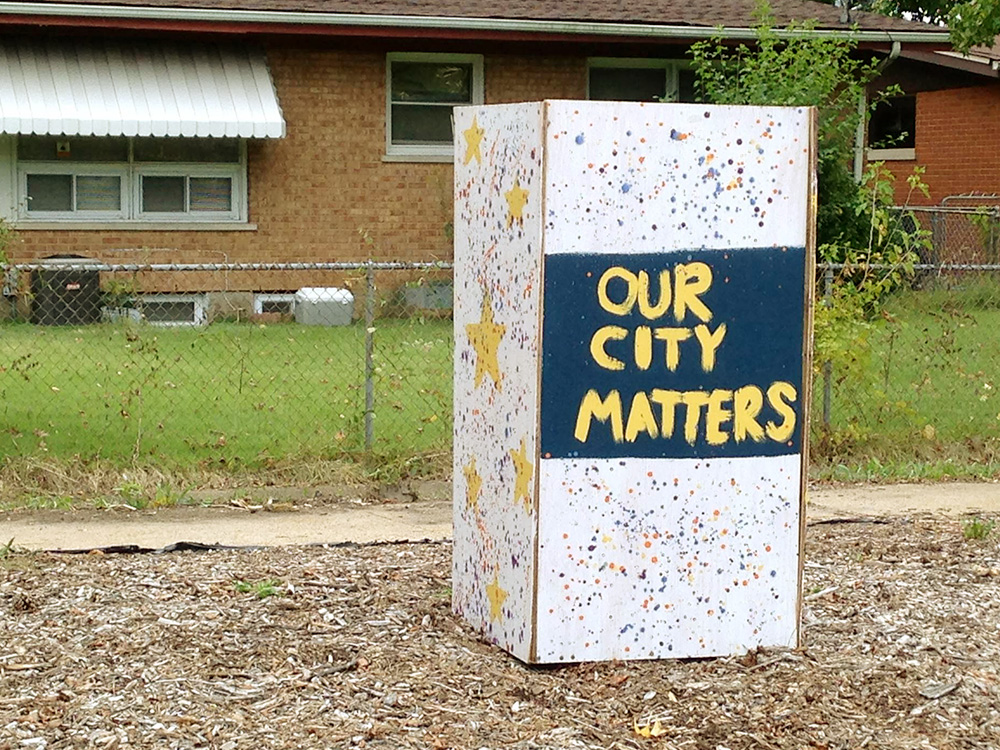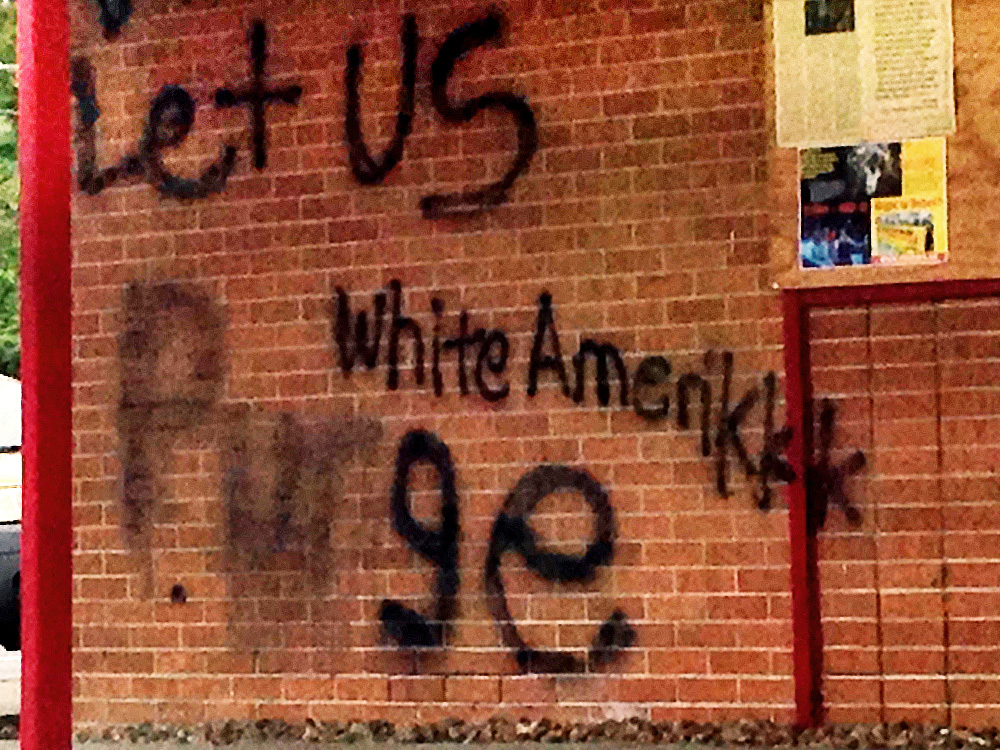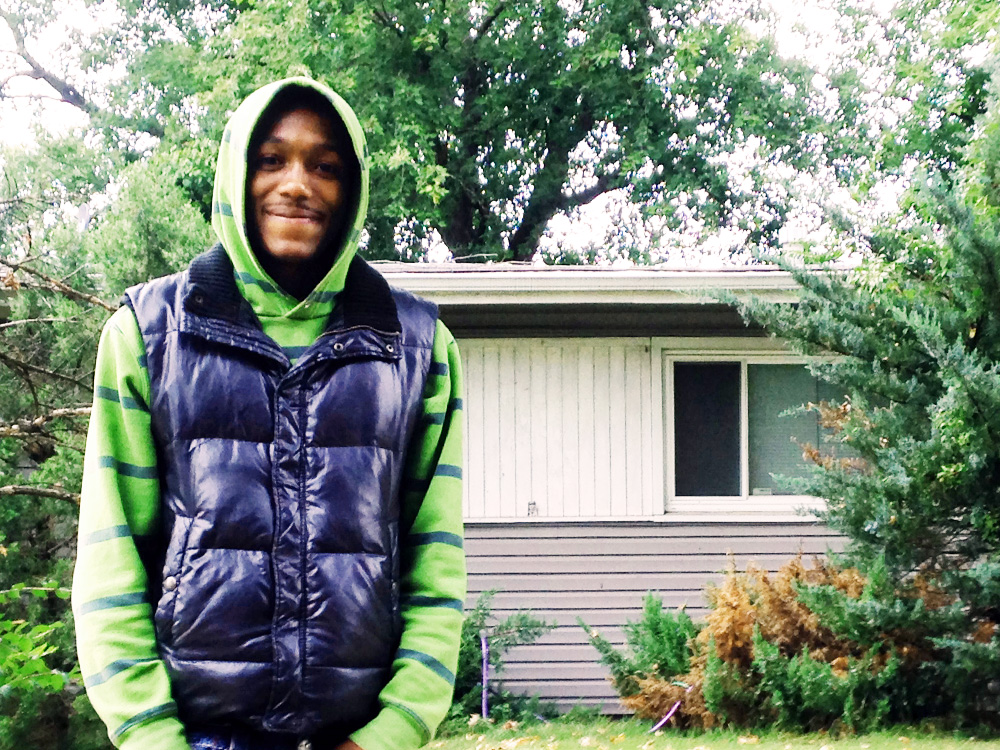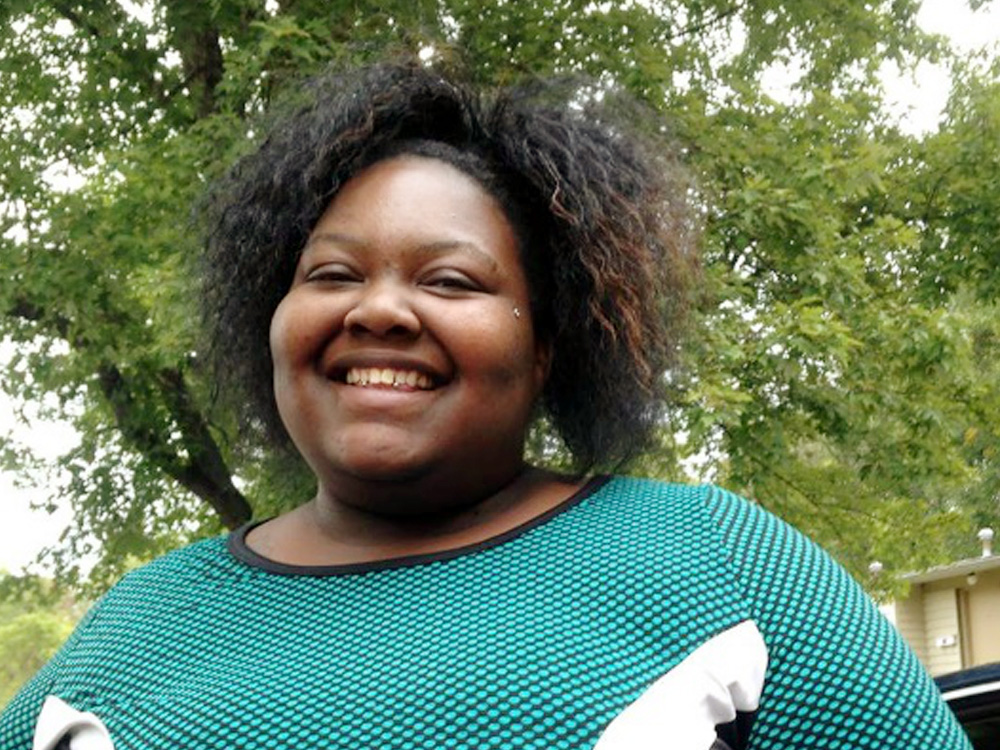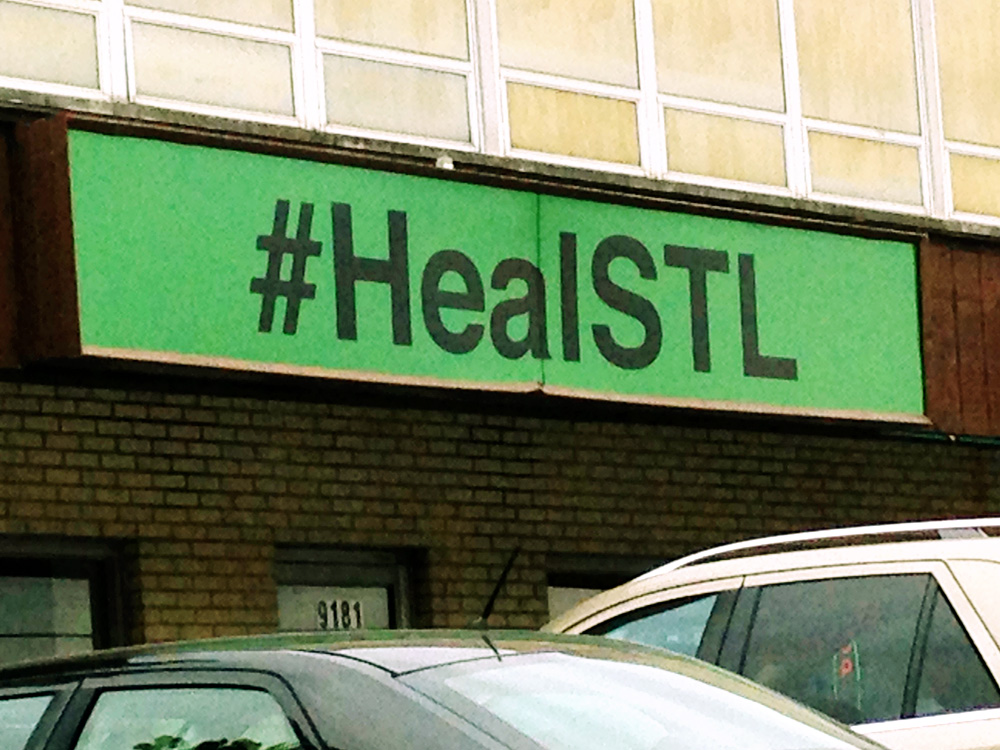"We are living and breathing it," says pastor Fred Winston. We’re sitting in Ferguson, Mo., in a threadbare tan and white church tucked into a grassy field about a minute from the spot where the Michael Brown/Darren Wilson shooting blew up the news. It’s early October 2015, a little over a year since parts of the city burned, and Ferguson became a parable on race relations and cops.
But what can you learn from an afternoon in Ferguson? Plenty, as it turns out.
Winston, a cautious African-American gentleman in his 70s wearing an unornamented black baseball cap and scuffed leather jacket, leans against a table garnished with pink plastic roses, bleached out from age. He seems eager not to take a firm stand, at least not to an out-of-town reporter who’s shown up unexpectedly at his church. It’s like that everywhere I go, though; the explosive anger has bubbled down into a sort of friendly wariness. People talk freely and are willing to do so at some length and with thoughtful nuance, but they mute their anger; if rage persists, it’s latent, as if they’ve assessed it’s now better unspoken.
"One bullet unearthed a lot of dirty laundry," the pastor says, periodically tugging on the tube that runs to an oxygen machine on the table as he talks about how the police harassed people with "wicked" ticket writing but have largely stopped that now; how black-on-black violence plagues this area, especially because the cops have pulled out, but how it’s always been violent here; about how he hears gunfire sometimes but doesn’t really feel unsafe because that’s a "different world" a block away (full of drugs) that he doesn’t get involved in; and how the national media carnival came and left, finally pulling up its tents, but the local reporters are pretty thorough. A couple times he starts to say something controversial but catches himself and rephrases.
It kind of seems like everyone’s pulled out now: the rioters, the agitators and the reporters who weren’t all from here anyway, as well as the cops who were (sort of, as the police force was largely white and the area where Brown died was largely black). They left behind the people who actually choose to live here – who make this their home, or their business, or their religious calling, or (now) their social cause – and the fading detritus of rioting past (anti-white graffiti, boarded up buildings).
But that hasn’t brought a sense of peace. The cops pulling back and – to some degree, locals feel – out didn’t solve problems that have existed here for decades. It didn’t stop young men from shooting other young men or little girls. It didn’t stop the hopelessness and the poverty that’s been sandwiched in this little pocket outside St. Louis for more than a few decades once the U.S. Supreme Court decided that it was discriminatory to use housing covenants to keep blacks out of towns like this one in a state that allowed slavery until 1865.
If anything, locals say, it feels more dangerous here without the cops. Or just as dangerous as it was before – which was pretty bad. That doesn’t mean the soul of Ferguson is defined by tragedy; that’s more complex too. Everything here defies a simplistic media-driven paradigm. The positive statement signs ("We must stop killing each other," "Our city matters") outnumber the angry ones. More businesses are open than boarded. But in other ways, it feels like little has changed. The same social ills that drew the cops exist without them.
Sometimes you can learn more about a place when the cameras have left, dragging their narratives and everyone’s agendas to the next national incident like fishing trawlers. The cameras capture a moment but not a history. Maybe the riot (or protest, or both) was a spontaneous combustion, a self-immolation (black-owned businesses were the ones that tended to burn). The painful cry from a never-ending seeping wound, just one of many skirmishes in a generations-old urban war without clear battle lines or foes, in which there’s no singular enemy. Maybe government policy set up the living arrangements that helped create the never-ending thread of tension between police and the residents of the low-income housing outside which Brown died, and maybe policing tactics, like constant ticket writing, exacerbated it – while arguably suppressing crime.
But the fact of the matter is that people in Ferguson don’t only fear the police. Never did. In fact, almost no one here brings up Michael Brown and what did or did not happen between Brown and the police officer. They’re talking about other stuff.
Indeed, the pastor tells me to go check out the new playground across the short field that abuts the New Covenant with Harmony church where we sit. "The media are over there," the pastor confides. A single St. Louis TV satellite truck has whizzed into the parking lot of Koch Elementary School for the installation of the playground set painted a child’s purple that’s surrounded by piles of freshly dug dirt. A boy runs around on a dirt pile, seemingly oblivious to the fact his playground is in the middle of the site of one of the biggest national news stories of recent times. Members of a historic African-American fraternity have come to the installation, although it doesn’t seem like it’s drawn a big crowd. The press release says the children in the school are still dealing with a fellow student’s shooting, so the playground will help them cope.
It’s this shooting that everyone’s talking about in Ferguson now, as it turns out, at least people who live here. In fact, we’ve been talking for an hour, and I realize Winston’s barely mentioned Michael Brown. Instead, he brings up Jamyla Bolden.
The little girl who went to the elementary school was shot and killed in August – the same month Brown died, a year later – while doing her homework inside her own home on her mother’s bed. And not by a cop. Her name was Jamyla Bolden, and she died in a house on a street that connects with Canfield Drive, where Brown died, a minute or so from Winston’s church.
Pastor Winston dials a friend on his cell phone. "How old was the girl again?" he asks, trying to remember the details of Jamyla’s death. "Nine," he’s told. Everyone’s familiar with it.
Fred Winston’s son of the same name – standing outside his father’s church a few minutes earlier, with its white steeple punctuating the gray skies – also immediately brings up the child’s shooting when he’s asked what it’s like in Ferguson now. "It was a drive-by. If you’re killing each other, why will people respect you?" he asks.
The alleged killer was arrested and charged within a couple of weeks. He was 21, from Ferguson and on probation for a gun-related crime. He would have been locked up, but he had received a suspended robbery sentence only last spring. It’s believed that he stood outside the home and fired into it, that he didn’t know the little girl – although the motive is unclear. It makes you think of Laylah Peterson, the little girl who died on her grandfather’s lap inside a home in Milwaukee.
I decide to walk the 30 seconds it would take to get to the playground next, but the pastor shakes his head, protectively. "You better drive," he sternly advises, even though we can see the playground from his church. You get the sense he believes the calm is but a façade that one must traverse carefully, as if walking on a plate of intact but fragile glass.
"That should have gone national," the pastor says of Jamyla’s death.
A land of teddy bears
Jamyla’s death was just the latest non cop-related shooting here, though. Ferguson today is a land populated by waterlogged, sun-bleached teddy bears. They are reminders of past life and death, like cotton-filled dinosaur bones. Around them, life goes on in Ferguson in a way that makes you think little has changed. They’re makeshift memorials, unsanctioned cenotaphs in an urban war, marking places where people were shot and killed – including Brown, but others too, people who were not shot by cops. The stories are mind-numbingly common – a guy shot in a drive-by, arguments that escalated. They exist in every big city in America. The stories, that is.
The teddy bears stare at you from chain link fences with emotionless plastic eyes, silent witnesses, and they form a jumbled line of stuffed fossils in the middle of the roadway where Brown lay (initially they covered his blood). There’s a small memorial plaque embedded in the sidewalk where the incident started a few seconds away from where it ended.
It’s as one-sided as the TV disorder imagery, focusing on Brown’s smiling demeanor in excessively flowery language (referring to echoes and whispers and afterglows), and ignoring the fact that a series of authorities found that he’d started to charge toward a cop who then lawfully defended himself. But the depiction of Brown as an amiable, smiling neighborhood fixture is a common one brought up by people who actually knew him; as with anyone and anything, he had many dimensions, a complex compilation of bad, good, and something in between. In death, though, he’s become a kaleidoscope, a Rorschach blot through which to imprint an agenda or make a point, the central protagonist of a story whom we still don’t really know. The same is true of Darren Wilson, of course, cast as villain or hero, a figure either way for central casting.
The teddy bears and other stuffed animals climb trees and dangle from streetlight posts. They look like wet puppies with their slicked back, rain-damaged fur. They are strangely animated inanimate bodies marking graves without bodies. They’re old. "They’re hunting all of us!" it says on the fat belly of one teddy bear. The marker looks faded, though.
The teddy bears are Ferguson’s version of those missing posters that grew up around Ground Zero in the days right after Sept. 11. The people they remember, though, died not from foreign terrorists, but at the hands of police (in the case of Brown, a justified shooting authorities found) and also at the hands of other residents who live here (drive-bys, neighborhood beefs, and the sort). Still, this is how the analogy works, somewhat: They are the tangible public markers of people who’ve been subtracted from society, left behind by those who don’t want them forgotten – the numbers spread out over years, though, and not concentrated in a single moment, a slowly unfolding mass murder with many potential perpetrators and points of view.
There’s a group of these bears around the corner, too, from the Brown memorial, where a girl with red hair the color of Kool-Aid says her "homeboy Twin" was shot. She can’t remember his full name. A few teddy bears also peer out from the chain link fence at the nearby McDonalds where two black men were killed in the area not long after Brown died. Their names were Robin Poindexter and DeAndre Joshua, victims of homicide.
The McDonald’s became a sort of rowdy public square during the riots. Reporters were arrested there, and people smashed the glass to get milk to put on the eyes of people stung by tear gas. The TV cameraman at the elementary school playground warns that people would run up to videographers and knock their expensive cameras to the ground. "$40,000 cameras!" he confides. Or they’d run up and literally snatch people’s cameras out of their hands, and take them. He was there the night Brown died; he arrived while Brown’s body still lay on the pavement. "Everyone was angry," he said, noting it was exacerbated by the fact that so many people in this compact area knew Brown. The cameraman doesn’t want me to print his name, or he might get in trouble.
Now, the downcast looking soggy bears at the McDonald's are the only sign that anything happened there. The most noticeable activity is people in the drive-thru buying hamburgers and cups of coffee or cars pulling into the Family Dollar parking lot across the street.
A town on fire
Ferguson burning on the nightly news is a disorder narrative embedded in the national consciousness. When you think of Ferguson, you think of tear gas and tanks. Maybe you took Officer Wilson’s side or that of #blacklivesmatter. We all know all about that binary debate. "Glad you survived," someone wrote on social media when they learn I am heading to Ferguson. I was in the area already. I was curious about what I would see.
There are some signs of revival in Ferguson. The first thing you notice other than the bears is that it’s not the rubble it appeared on the nightly news. Locals like the pastor say the Brown incident brought both good and bad into the area. Some jobs were lost because black-owned businesses were burned down, which they consider bad and counter-productive, but other jobs and some attention to important issues came. One business bears a large sign that simply says #HealStL.
The statement signs dot the lawns of many homes, including one around the corner from the spot where Brown died. "We must stop killing each other," they declare. They aren’t isolated to a few lawns. Jamyla’s house had one. "There’s resiliency here," says Andrew Cleveland, 37, who was at the playground commemoration for Jamyla, representing the historic black fraternity. "Our city matters," says another.
Winston thinks some of that dirty laundry needed to be churned up because the constant ticket writing by the police in such a small concentrated area created a never-ending cycle that some people couldn’t climb out of when they wanted to better themselves. When locals bring up the police, it’s their writing of tickets they fixate on, not shootings. Winston thinks it was harassing and that it’s done less now. Numbers bear out a change; the local newspaper reported ticket revenue was down by $1 million as of June.
However, the police pulling back from a proactive, more aggressive constantly visible strategy – think Broken Windows in New York – hasn’t improved the lives of young African-American men who still live and walk around here (it seems to be a foot-traffic based society, at least in part). Many of the things locals talk about involve neighborhood disorder – black-on-black violence and poverty. St. Louis, as with Milwaukee, is one of the cities leading the nation in homicide spikes.
The same problems that have challenged America for decades exist here now and did so before Brown and Wilson met. Most of Ferguson you didn’t see on the news. The spot where Brown died is a dense cluster of low-income apartments, called things like Canfield Green and Northwinds, densely packed into a relatively small area off a commercial thoroughfare, urban poverty that migrated to the suburbs. Think the former North Meadows project on Milwaukee’s far northwest side. It’s like someone took Chicago’s Cabrini-Green high rise and just laid it out horizontally, and in a suburb.
The low-income housing is marooned off a busy commercial thoroughfare, a project within a suburb, some distance from St. Louis itself. A minute and you’re out of it. Of course, you can’t really know what it’s like to live in Ferguson unless you actually live there. You can just scratch the surface, see what you see, the visible layer. Cars drive to and fro, and lots of people are walking, to and fro, as Brown was doing that night. An empty shopping cart sits on a corner.
As recently as the 1940s, covenants banned blacks from owning homes in the suburbs around St. Louis; zoning laws and other policies were designed to maintain racial segregation. When a black man tried to move near Ferguson, a neighbor sued to enforce the covenant. But the U.S. Supreme Court eventually banned Missouri from enforcing such covenants, and that’s when the migration started, creating this mini city within what used to be an all-white suburb.
The TV cameraman says there are a handful of impoverished pockets like this that exist around St. Louis, and they are congested with crime and have been for years. Everyone knows where they are. This is one of them. Always has been. The only difference is the anger is more obvious, "I don’t drive through there now, not with this truck," he says. "They throw things at the truck." The news team is headed to a benefit for a firefighter after the playground event.
Local media has reported that 18 percent of the area’s crime emanated from that area. Ferguson over the years switched from a farming town to a hamlet of St. Louis commuters, and the city annexed the Canfield Green area in the 1960s. You can’t live in apartments like Canfield Green or Northwinds if you earn too much money. It’s concentrated poverty, which brought with it social ills and misbehavior that inevitably drew the police, charged with the responsibility for stemming the disorder, who then inevitably clashed with all the guys on foot who move around here. It’s racially segregated too. Most of the faces in the area where Brown died are black; Ferguson’s roughly 21,000 population overall is about two-thirds so (a percentage that is growing).
Ferguson is not unique, as it turns out. It’s the story of urban America, happening in cities all over the country, including Milwaukee. It feels static, a tale we’ve all heard many times. That doesn’t surprise me particularly; I expected it. But it does stand out. Some news accounts say some of the locals are gone now too; one sign advertises "move in specials" outside the low-income housing.
Ferguson brings to mind a fish boil, or so it seems. The Wilson/Brown incident was simply the kerosene tossed on the already boiling water, causing the water to spill over for a time. The water’s receded, but it’s probably burbling beneath the surface just as hot. And it’s not only the cops that turned up the heat.
There’s some in-your-face graffiti. "Let us purge white Amerikkk" is emblazoned on a boarded up business, but it seems angrily out of place now on a commercial strip where people are simply going about their Saturday business with expressionless faces. "We back out here," says the wall of one store next to a quote from Maya Angelou.
Pastor Winston’s son says most of the people doing the agitating and the burning were out-of-towners anyway. "Those people weren’t from here," he confides.
"I’m not safe"
Damonta Johnson is one of the young men constantly navigating on foot. He walks alone about a block from where Brown died, a reedy figure in his 20s wearing a lime green hoodie under puffy nylon black vest. If you want to understand what it’s like to live in Ferguson, you can’t just talk to guys in their 70s.
"I was locked up during Milwaukee," he volunteers when I introduce myself as a writer from that town. "During Milwaukee?" I’m confused at first. It’s interesting that he feels no shame whatsoever in introducing himself to a stranger by revealing he was once in jail.
"Someone got killed in Milwaukee by the police ... Eric Garner," he continues, clearly referring to the Dontre Hamilton death but mixing up the names of black men who died after encounters with the police and received extensive media attention.
"What’s it like to live in Ferguson?" I ask Johnson.
"Like I’m not safe," the young man says.
That’s a jarring comment, not unexpected but completely revolting in its harsh truth, that a young man like this in America has to live in a world where he just literally never feels safe.
Did he feel safe before? "No."
Does he feel less safe now? "Not really."
Who or what’s making him feel unsafe?
"Everybody. My own kind. The police."
Johnson knew Michael Brown; in fact he saw him the day he was shot. It was an uneventful encounter; they said "what’s up" as they navigated past each other on foot. Brown was going to the store. Brown was well known in the neighborhood of these low-income housing complexes. He smiled a lot and people liked him, Johnson says; he was a big guy so he stood out.
Johnson also says the police have basically left now, though. And he thinks there’s more crime as a result. You realize all of a sudden that the entire time – for three hours here – you haven’t seen a single cop. Not one. Not a single squad car, either. There’s a faint siren in the distance at one point, though. There doesn’t seem to be any community-oriented policing or proactive foot patrols going on in Ferguson. It’s as if the cops have vanished.
"People used to be worried about the police seeing them so they wouldn’t do stuff, but the police never come here now," Johnson says. It’s kind of a free-for-all, and he’s living in the midst of it.
Ferguson police tell OnMilwaukee that, "Our mission is to continue to protect and serve all citizens in the Ferguson community." The police say they've launched several initiatives, including holding a recent meeting at a local church. Asked about some residents' perception that the police have basically pulled out of the area where Brown died (other than for major calls), the police said, "Regarding the claim that officers do not respond to the Canfield Green location, the Ferguson Police Department responds to all calls from citizens in need of services. The Ferguson Police Department also patrols our ENTIRE city on a daily basis including subdivisions, apartment complexes and business/commercial districts."
Johnson decides that, if he has to pick, he’s glad the cops are around less – at least in his perception. He once got a ticket for boxing with actual boxing gloves in his driveway with a friend. They said he was disturbing the peace. "Then you run, and you get another charge." He was locked up "during Milwaukee" for burglary. He says he’s now going to a local college.
Why doesn’t Johnson leave Ferguson if he feels unsafe in it? Why live here?
"I ain’t got no choice," he says. Why not? He shakes his head as if he doesn’t really know; he just thinks he doesn’t have one.
"Hard times."
It’s all connected
Around the corner from where Brown died, two young women climb into a car near the teddy bear memorial that spills out from the base of a tree. "It’s all connected," the girl says, but she can’t quite articulate how. "I just feel it’s connected," she keeps repeating. "Why does everything happen in Ferguson?" She decides she doesn’t want to talk anymore and slips away before giving her name.
Her friend, Mariah Tony, 24, has a perpetual friendly smile on her face. "It’s more ghettoized in the area since Brown died," she volunteers. What does she mean by that?
"Gunshots all the time." Crime is up because the police "don’t pull anyone over anymore." But they do come faster and "seem more concerned" when something big happens, she adds.
Tony says Missouri was the last state to free slaves. In the 1700s and 1800s, Missouri was a land of "slave codes" that regulated the lives of blacks, subjected them to horrors and eliminated their freedoms. As late as 1847, it was illegal to give blacks an education. Missouri ended slavery in 1865; the Emancipation Proclamation hadn’t applied to it). She says the minimum wage is just $7.75 (it’s actually $7.65). When we’re done talking, I realize that almost no one is talking about what Officer Wilson did or didn’t do to Michael Brown. They’re upset about a lot of other stuff. Probably always were, to some degree. In a way all the focus on the cops diverted attention from deeper issues that have existed here for generations (although the Justice Department did find a series of problems in how the area was policed).
Back at the church, Winston has now been joined by a parishioner, William Roe. The parishioner is an African-American Vietnam veteran who saw combat, a former soccer coach and a former teacher. Roe demonstrates the complexity of the problems that exist in Ferguson, problems simplified by the media and agitators too. He’s had eight of his former students die; he went to three funerals in the past year. "We stand over the caskets," agrees the pastor.
Roe is concerned by what he calls police harassment. He’s been stopped by police before the Brown/Wilson incident while driving around here for what he thought was no reason. "They got harsh" in tone, he says, which, as a former military man, he doesn’t take kindly to. "I tend to get harsh back." He agrees that’s dropped off now, though. But it’s hardly the end of his concerns.
Roe believes low-income housing shouldn’t be clustered in one spot like it is in the area where Brown died – "spread it out," he says. "They direct people in poverty to live together. They’re all bunched together." "They" means the government.
His other solutions fall across the political spectrum. He wants all guns in the country banned. The Founding Fathers were farmers organized in militias, he says; they didn’t have the level of violence that’s occurring. He’s extremely angry about immigration. He goes on a rant about "Asians, such as Vietnamese" who come to America and take jobs, while black Americans remain jobless even though "we were with this country from the start." He kind of sounds like a Trump supporter. "Well, he has a point," Roe says, before adding, "but I don’t agree with all of the ways he says things." He says the first man who died in the Revolutionary War was black. "They don’t tell you that in the history books." He’s talking about Crispus Attucks, an Indian and black man who was shot in the Boston Massacre.
"We’ve been here every step of the way, but we’ve been excluded from the good jobs, the education," says Roe.
But he also wants juveniles who use guns or commit crimes locked up for stiffer sentences. He thinks the juvenile laws need to be toughened overall. "If you’re man enough to carry the gun, you’re man enough to do the time," he insists.
What’s causing the violence, in his opinion? He doesn’t think it’s poverty that’s driving it.
"Status," he says.
The parishioner describes one recent homicide involving someone he knew in which the victim had slapped the killer’s sister, so the killer felt he had to act the "protector" and shot him. Young men feel an extreme need to obtain status, and the way they think they can do that is violence. How to make them understand they can achieve status without resorting to shooting someone? "Now that’s the question; that’s it," he says. It’s interesting that he, too, has barely mentioned Brown.
A flash of defiance emerges then. He pauses and wonders, "Why didn’t they just burn down the police station?" He and the pastor agree that would have been a better choice. They don’t sound like they think that would have been a bad thing. You wonder how they talk to each other instead of to an outsider.
They decide the police had it too well-protected, so the black businesses burned instead. But then Roe adds that he likes some of the cops because they are his former students, nine of them, guys who used to play football. "There are some of them who stop by my driveway, and we talk all the time," he says.
It’s complicated here in Ferguson. Then again, that’s life. Away from the headlines anyway.

